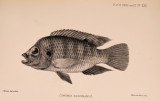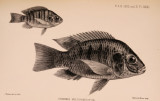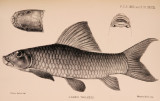| OCR Text |
Show 1902.] PLECTCGXAT IiO US FISIl ES. 285 although there can he no question as to the close relationship of the less specialized forms to the Acanthuridse, their differences from that family are sufficiently great to admit of a definition which separates them from the Acanthopterygii, and at the same time includes the more aberrant and specialized forms. The feature of most importance in diagnosing the suborder Plectognathi is the absence of ribs, although in some well-ossified epipleurals are present which have been mistaken for ribs. Two divisions are recognized, for which the names Sclerodermi and Gymnodontes, originally proposed by Cuvier, are retained. The Triodontidse, however, are removed from the latter division and placed in the former, the structure of their pectoral arch and vertebral column, as well as the presence of a pelvis and of well-ossified epipleurals, indicating their close relationship to the Triacanthidse and Balistidse; whilst the coalescence of the teeth in the jaws is a feature of little importance, and has, as probably as not, originated independently in these fishes and in the Gymnodontes. The Ostraciontidse do not seem to me to differ sufficiently from the Sclerodermi to rank as another division-Ostracodermi. Their very close relationship to the Balistidse is apparent in their physiognomy and in the structure of their skeleton; whilst the absence of epipleurals and of the pelvis is obviously due to the development of the exoskeleton, which, however, is not very different from that of Balistes, many species of which have exoskeletal plates distinctly hexagonal in certain areas. I have inserted notes after the diagnoses, explaining the omission of characters before used or the addition of those now used for the first time. Suborder PLECTOGNATHI. Similar to the Acanthopterygii, but without ribs ; with the posttemporal short, simple, and completely united by suture to the squamosal, and the pelvic bones, if present, more or less completely co-ossified. Branchial apertures very restricted. Prc-maxillaries and maxillaries often firmly united, opercular bonus more or less reduced, and scales usually osseous or spinate. Cuvier characterized the Plectognathi as having no ribs, but other systematists have generally agreed that ribs are present in Balistes, Triacanthus, Trio don, &c. I find that the so-called ribs of the Triacanthi dse and Balistidse are epipleurals, which are attached to the anterior caudal vertebrae as well as to the prsecaudals (text-fig. 56, p. 286), and are intermuscular bones, not bordering the abdominal cavity. I have unfortunately had no opportunity of examining the skeleton of Triodon, but have had to rely on the memoirs of Hollard 1 and Ilareste *; but I think I am justified in supposing that m *1 nocton, as m Balistes and J. i tacanthus, 1 Ann. Soi. Nat. (3) xx. 1853, p. 71 ; (4) viii. 1857. p. 275, na ....1 /->\ i ozi \ 1 ia kn"d (4) xiii. I860, p. 1. |
































































































































































































































































































































